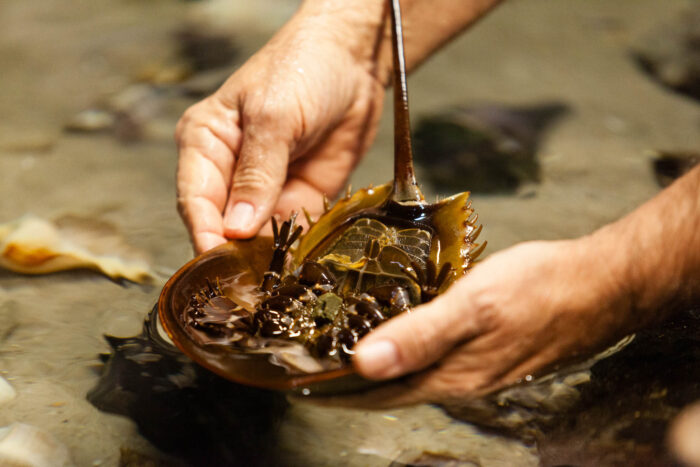Horseshoe crab
Limulus polyphemus
The horseshoe crab is a primitive-looking arthropod with a hard, brownish-green exoskeleton and a spike-like tail. It visits the Chesapeake Bay’s sandy beaches each spring and summer to spawn.
This section shows one large critter image at a time. Use the thumbnails that follow to select a specific image to display here.

This gallery contains a grid of small thumbnails. Selecting a thumbnail will change the main image in the preceding section.
Appearance
Horseshoe crabs grow to two feet in length. They have a hard, rounded, brownish-green exoskeleton, a spike-like tail and five pairs of jointed legs. Their widely spaced eyes look like bumps on the top of their shell. Their gills have folds of membranes that look like the leaves of a book. Juveniles are sand-colored.
Feeding
The horseshoe crab eats mostly worms and mollusks such as razor clams and soft shell clams. It spends most of its time rooting through bottom sediment looking for food. Because they lack jaws, these crabs use the spiny bases of their legs to crush and grind their food, then push it into their mouths.
Predators
Several types of shorebirds eat horseshoe crab eggs. Various fish, invertebrates and sea turtles feed on eggs and larvae. Humans catch adult horseshoe crabs to use as bait and for medical research.
Reproduction and life cycle
Spawning takes place in spring and summer (peaking in May-June), usually during evening high tides when the moon is full or new. Large numbers of adults crawl up onto sandy, protected beaches to mate and lay eggs.
Females lay clusters of about 4,000 greenish eggs in the sand around the high-tide mark. They return to the beach to lay more eggs during high tides throughout the season. Eggs take about one month to develop and hatch. Young swim to shallow, sandy, protected nursery areas, where they remain for up to two years.
Did you know?
- Horseshoe crabs are not true crabs, and are more closely related to terrestrial spiders than blue crabs.
- Often called "living fossils," horseshoe crabs have existed for more than 300 million years.
- Although their spikes and spines may look dangerous, horseshoe crabs are harmless.
- Just like other arthropods, horseshoe crabs must molt to grow. They leave their old shells behind and grow a new, larger shell.
- Horseshoe crabs swim upside down and can survive out of the water for an extended period of time if their gills are kept moist.
Sources and additional information
- Life in the Chesapeake Bay by Alice Jane Lippson and Robert L. Lippson
- Maryland Fish Facts: Horseshoe Crab – Maryland Department of Natural Resources
- Animal Diversity Web: Limulus polyphemus – University of Michigan Museum of Zoology
- Limulus polyphemus – MarineBio
- The Horseshoe Crab – Ecological Research & Development Group
